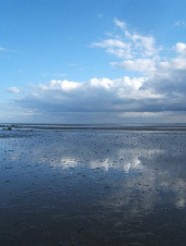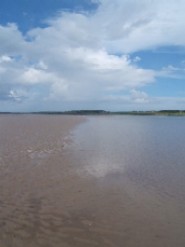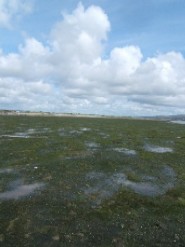ntertidal mudflats and sandflats are submerged at high tide and exposed at low tide and are normally associated with inlets, estuaries or shallow bays. The physical structure of these intertidal flats ranges from mobile, coarse-sand beaches on wave exposed coasts to stable, fine-sediment mudflats in estuaries and other marine inlets. For the purpose of this review, a minimum size of 0.5 km2 was used. These habitats support diverse communities of invertebrates, algae and eel grass (Zostera sp). Mudflats are usually located in the most sheltered areas of the coast where large quantities of silt from rivers are deposited in estuaries. In sheltered areas communities are typically dominated by polychaete worms, e.g.,Arenicola and bivalve molluscs and may support very high densities of the mud-snail Hybrobia ulvae. Sand flats occur on open coast beaches and bays where wave action or strong tidal currents prevent the deposition of finer silt. On more exposed coasts the biodiversity may be lower and the communities dominated by crustaceans such as Bathyporeia. The strand line on most shores is characterised by Talitrid amphipods. Where Zostera occurs, faunal diversity is higher. The high biomass of invertebrates in such sediments often provides an important food source for waders and wildfowl, such as Knot (Calidris canuta), Dunlin (Calidris alpine) and Sanderling. Intertidal mudflats and sandflats can be part of a mosaic of habitats that occur in estuaries and shallow inlets and bays. The area of mudflats and sandflats in Ireland encompasses 566.3 km2. The two largest sites are located in the mid-west (Shannon Estuary) and north-east (Dundalk Bay).
 |
 |
 |
|
Mudflat, Dundalk Bay (Photo: Aquatic Services Unit) |
Sandflat, Tralee Bay (Photo: Aquatic Services Unit) |
Zostera Bed, Tralee Bay (Photo: Aquatic Services Unit) |
Typical species include invertebrate communities such as Polychaeta: Tubificoides, Capitella, Malacoceros; Arenicolamarina, Hediste diversicolor, Lanice conchilega; Bivalvia Molluscs: Abra alba, Mytilus edulis, Cerastomderm edule,Scrobicularia plana, Macoma balthica, Mya arenaria; Crustaceans: Talitrd spp., Bathyporeia spp., Corophium spp.; Echinodermata: Echinocardium cordatum; Algal species: Ulva sp., Enteromorpha spp.; Angiosperm: Zostera spp.; Birds: Pale-bellied Brent Goose (Branta bernicla hrota), Oystercatcher (Haematopus ostralegus), Dunlin (Calidris alpina), Sanderling (Calidris alba), Sandwich Tern (Sterna sandvicensis), Common Tern (Sterna hirundo), Ringed Plover (Charadrius hiaticula), Bar-tailed Godwit (Limosa limosa), Redshank (Tringa totanus), Knot (Calidris canutus), Golden Plover (Pluvialis apricaria) may use the areas for either roosting or feeding; Mammals: Harbour Seal (Phoca vitulina), Grey Seal (Halichoerus grypus).
A Survey of Intertidal Mudflats and Sandflats in Ireland ![]() (16,874KB)
(16,874KB)
Year: 2007
Author: Aquatic Services Unit
A Survey of Intertidal Mudflats and Sandflats in Ireland ![]() (16,628KB)
(16,628KB)
Year: 2006
Author: Aquafact
